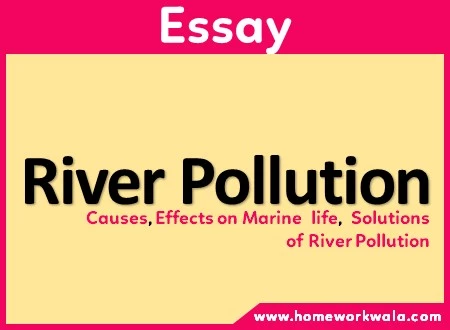Table of Content
Today, In this article we are going to write essay on River Pollution in English in 700 words.. This article is about River Pollution.
This post can help the school students who are looking “River Pollution par nibandh English mein”. We briefing about “River Pollution in the English” which is very useful for student.
This essay on “River Pollution” is generally useful for class 7, class 8, class 9 and 10.

Simple essay on River Pollution in English
Introduction
Rivers are an essential resource for both human and animal life. They provide water for drinking, irrigation, and industrial use. Rivers also serve as habitats for fish and other aquatic life. Unfortunately, human activities have led to the pollution of many rivers around the world. River pollution is a significant problem that has far-reaching effects on our environment and health.
Causes of River Pollution
There are several causes of river pollution, including industrial waste and chemical pollutants. Many industries release toxic substances into rivers, including heavy metals, dyes, and solvents. Agricultural runoff and pesticides are also significant sources of river pollution, as they can wash into rivers and contaminate the water. Sewage and wastewater discharge from cities and towns are other significant contributors to river pollution. Oil spills and other accidents can also pollute rivers, causing damage to wildlife and ecosystems. Finally, illegal dumping and littering can also contribute to river pollution.
Effects of River Pollution
River pollution has harmful effects on human health, particularly for those who rely on the river for drinking water. Contaminants in the water can cause skin rashes, stomach problems, and other illnesses. River pollution can also damage wildlife and ecosystems. Toxic substances in the water can kill fish and other aquatic life, leading to a decline in biodiversity. Negative impacts on tourism and recreation are also a consequence of river pollution. Finally, river pollution can have economic consequences for communities that rely on the river for their livelihoods.
Efforts to Reduce River Pollution
Governments have implemented regulations and policies to reduce river pollution. For example, many countries have established limits on the number of pollutants that can be released into rivers. Corporations have also taken steps to reduce their environmental impact and hold themselves accountable for any pollution they cause. Community involvement and education are critical in reducing river pollution.
Awareness campaigns and community cleanups can encourage people to be more mindful of their impact on the environment. Finally, technology and innovation have led to the development of new solutions for reducing river pollution, such as wastewater treatment plants.
Case Studies
There have been successful river cleanup and restoration projects around the world. For example, the Thames River in London was once heavily polluted, but efforts to reduce pollution have led to a significant improvement in water quality. Communities affected by river pollution have also taken action to address the issue. For example, the Standing Rock Sioux tribe in the United States fought against the construction of an oil pipeline that threatened their water supply.
Conclusion
River pollution is a serious problem that has far-reaching consequences. It is essential that individuals, communities, and governments take action to reduce river pollution. By implementing regulations, promoting corporate responsibility, educating the public, and using technology and innovation, we can work towards cleaner and healthier rivers. The future health of our rivers and waterways depends on our actions today.
You May Also Like
FAQ about River Pollution
- What is river pollution?
- What are the causes of river pollution?
- What are the effects of river pollution?
- What can be done to reduce river pollution?
- Are there examples of successful river cleanup and restoration projects?
- What can individuals do to help reduce river pollution?
River pollution refers to the contamination of rivers and other waterways with harmful substances, such as chemicals, sewage, and waste.
The causes of river pollution are many and varied, including industrial waste and chemical pollutants, agricultural runoff and pesticides, sewage and wastewater discharge, oil spills, and illegal dumping and littering.
River pollution has harmful effects on human health, wildlife and ecosystems, tourism and recreation, and local economies. Contaminants in the water can cause illness, kill fish and other aquatic life, discourage visitors, and harm the livelihoods of those who rely on the river for their livelihoods.
Governments, corporations, and individuals can all take steps to reduce river pollution. These include implementing regulations and policies, promoting corporate responsibility and accountability, involving communities in cleanups and awareness campaigns, and using technology and innovation to develop new solutions.
Yes, there have been successful river cleanup and restoration projects around the world. For example, the Thames River in London was once heavily polluted but has seen significant improvement in water quality thanks to efforts to reduce pollution.
Individuals can take steps to reduce their own impact on the environment, such as properly disposing of waste, reducing their use of chemicals, and participating in community cleanups and awareness campaigns.
We hope you like this post about essay on River Pollution in English. We are very glad to help the students to do their homework in an effective way. This was a “River Pollution ka essay English mein”. This type of questions generally asked the students in their schools to write essay on River Pollution.